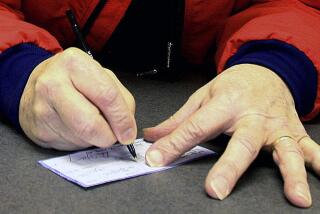Before You Send Money, Check Fees
It’s a rare parent who will never have to respond to the age-old query: “Could you please send money?” Now that school has started, it is just a matter of time before such phone calls start rolling in.
The reasons behind those frantic calls home hardly change over the decades--emergencies, unexpectedly high expenses or simple overspending. But now, because of increasingly sophisticated technology and cooperative agreements between banks, parents have more ways of sending money. But some options are far more costly than others.
What are the options? Wiring money; securing a cash advance against a credit card that’s in your child’s possession; using an automated teller that’s part of a teller “network” or simply sending a check. Which option to choose depends on how quickly your child needs the money and how much it costs.
Here’s a breakdown of how much you would spend to send between $200 and $500 to your scholar.
- A traditionalist might wire funds, but on a per-transaction basis this is expensive. Western Union’s fees vary with the amount being sent and whether the sender pays with cash or credit card.
Those who pay cash will be charged $22 to send $200 anywhere in the United States. Add $5 to the fee if you use a credit card--and most people do when they order money over the phone. If you’re sending $500, the fee will be $40 (cash) or $45 (credit card). The recipient must go to a Western Union office to collect the dough.
American Express also sells “money grams,” but telephone orders are possible only for those who hold American Express Optima cards. The fee is $15 to send up to $300 and $30 to send more, up to $500. (Those who don’t have Optima cards can go into an American Express office and pay with cash or another credit card.)
Western Union and American Express say the transferred funds typically are available to the addressee in an hour.
Parents can also wire money through banks. The fees typically range between $5 and $25--and they often get you coming and going. For example, the parent may have to pay $25 to send the money and the student $10 to receive it. Generally, these are flat fees, so how much you send doesn’t matter. The money is often--but not always--available the same day.
* A student with a credit card can get a cash advance. The fee usually is about 1% to 2% of the amount borrowed.
American Express says its cash-advance fee--also available only to holders of Optima cards--is $2 to $6. Other credit card issuers may charge up to $10, and if the advanced amount is not immediately repaid you must add the cost of borrowing on credit, which often amounts to about 20% a year. If a balance is left on the card for the whole year, the interest charges on $200 would add up to about $40.
* Some parents may have a cheaper option if the child has a bank account and an automated teller card.
Many big banks are members of automated teller “networks” that crisscross the country. The networks, essentially co-operative agreements between banks, allow bank customers to withdraw cash virtually anywhere in the country for a fee, usually between 50 cents and $4.
The way it works is simple: The parent deposits money in the student’s hometown account. The student withdraws it by using an ATM machine hooked up to a network serving his or her bank.
Usually this is a cost-effective option, but there is one caveat: College students tend to use ATM cards frequently to make small withdrawals--anything from $5 to $20, according to Ron Reed, senior vice president and manager of the Denver-based Plus System’s ATM network.
If there is a fee for every ATM transaction, that can get costly. If the student withdraws $200 in $10 increments, for example, the cost of passing cash via ATM jumps to $40--assuming a $2-per-transaction fee--and the price of sending $500 soars to $100.
* The least-expensive way to send money is to use the mail. It usually takes at least a week for your child to get use of the cash, between the mail and a possible hold on your check. But if you aren’t paying any per-check fees, the cost of sending money is just a 29-cent stamp.
“HI, MOM. SEND MONEY!”
It’s expensive enough these days to send a child through college without having to worry about how much it costs to get money to campus in a hurry. Here are a few options to consider:
Wiring money: If you pay cash to wire $200 via Western Union, the charge will be $22. Add $5 more if you use a credit card. American Express Optima cardholders can buy “money grams” over the telephone. The fee is $15 to send up to $300. Parents can also wire money through most major banks for a fee of $5 to $25, sometimes collected at both ends of the transaction.
Credit card cash advance: Cash advances cost between $2 and $10, depending on the card. If you don’t pay off the advance immediately, add the interest costs to the equation.
Automated teller: The parent deposits money in the student’s hometown account. The student withdraws it by using an ATM machine that’s hooked up to a network serving the bank the student uses. The cost is usually between 50 cents and $4.
Sending a check: Checks take a few days to get there by mail and a few more to clear the bank and become available. But you can’t beat the cost: 29 cents for a stamp.
More to Read
Inside the business of entertainment
The Wide Shot brings you news, analysis and insights on everything from streaming wars to production — and what it all means for the future.
You may occasionally receive promotional content from the Los Angeles Times.









